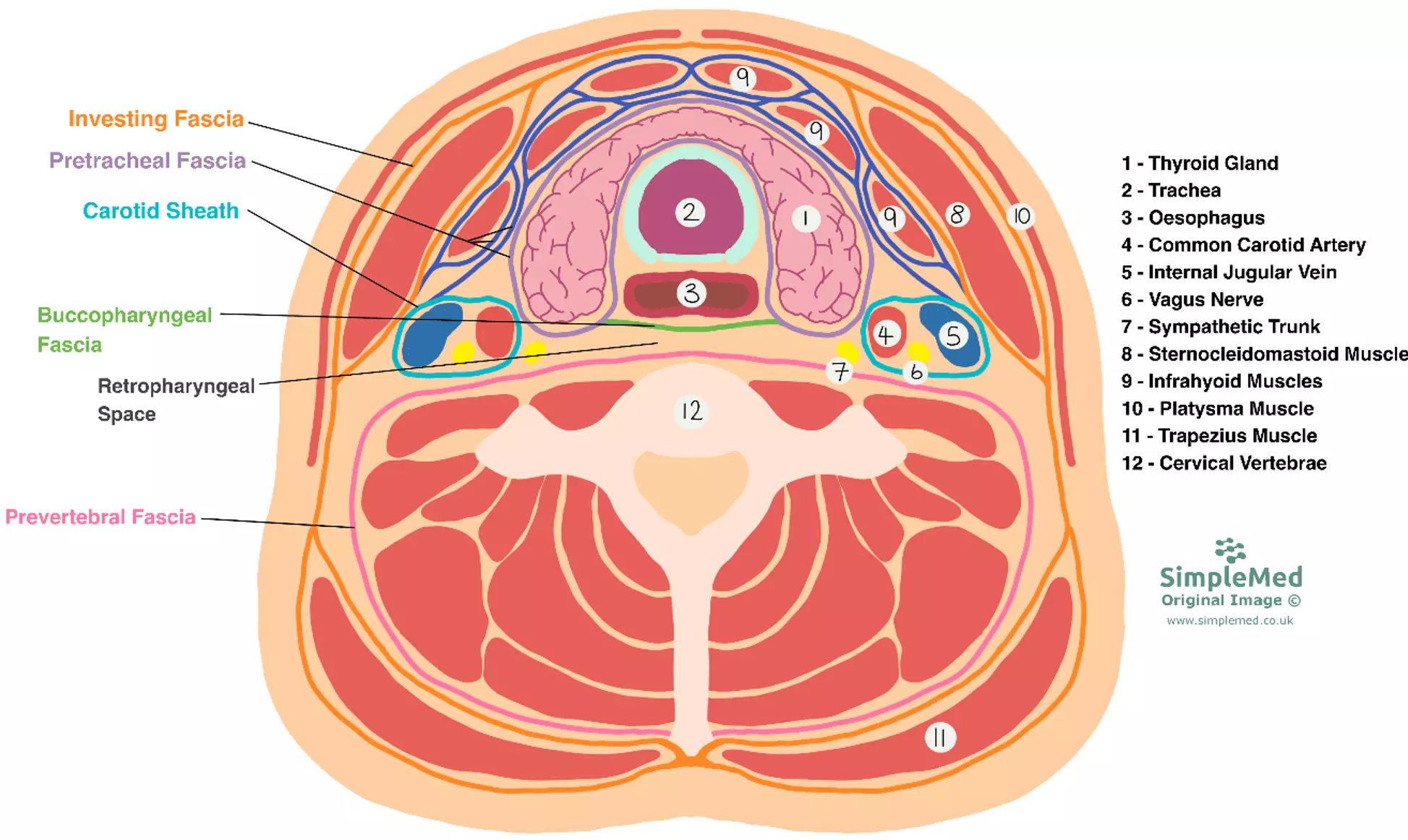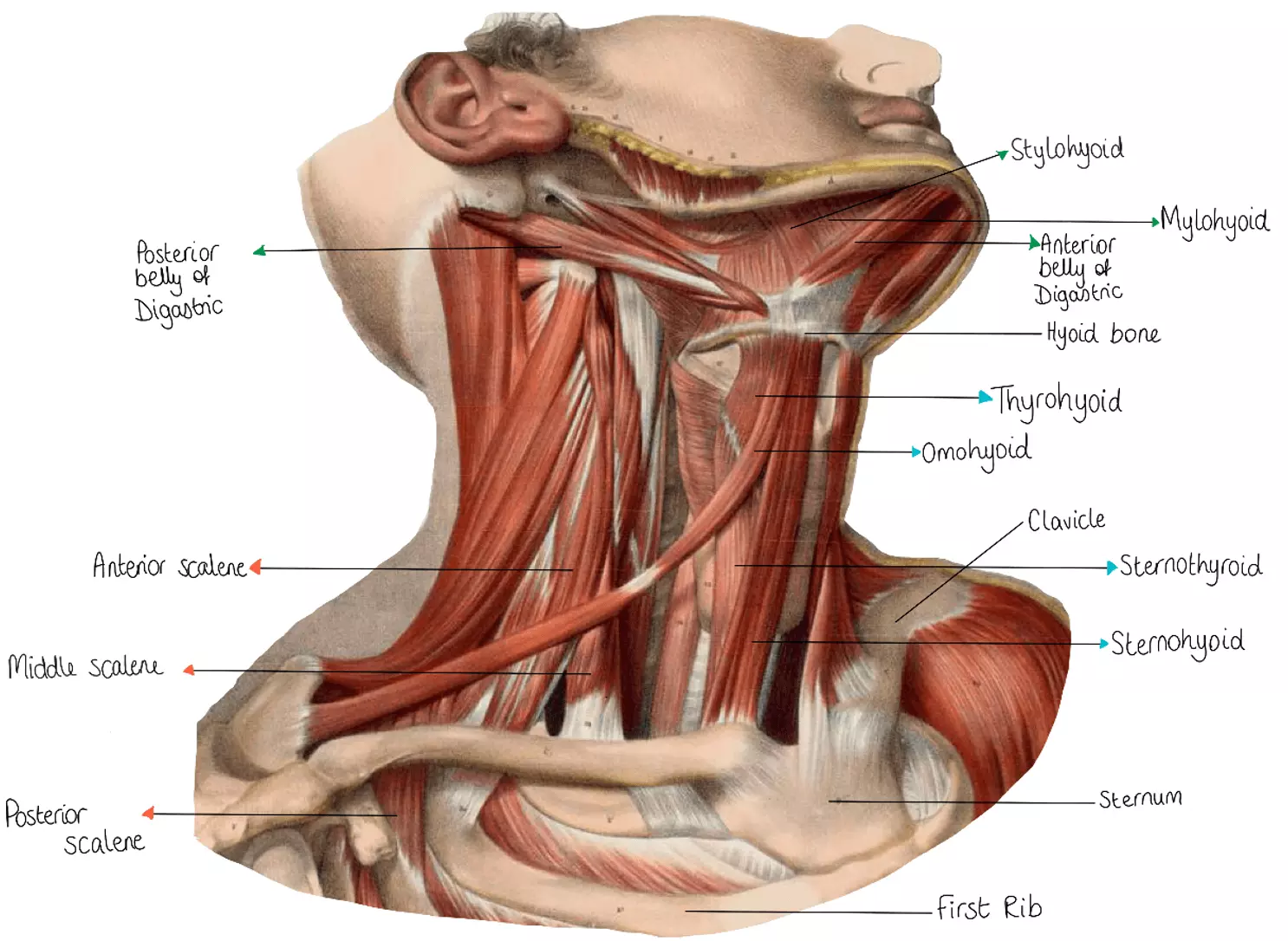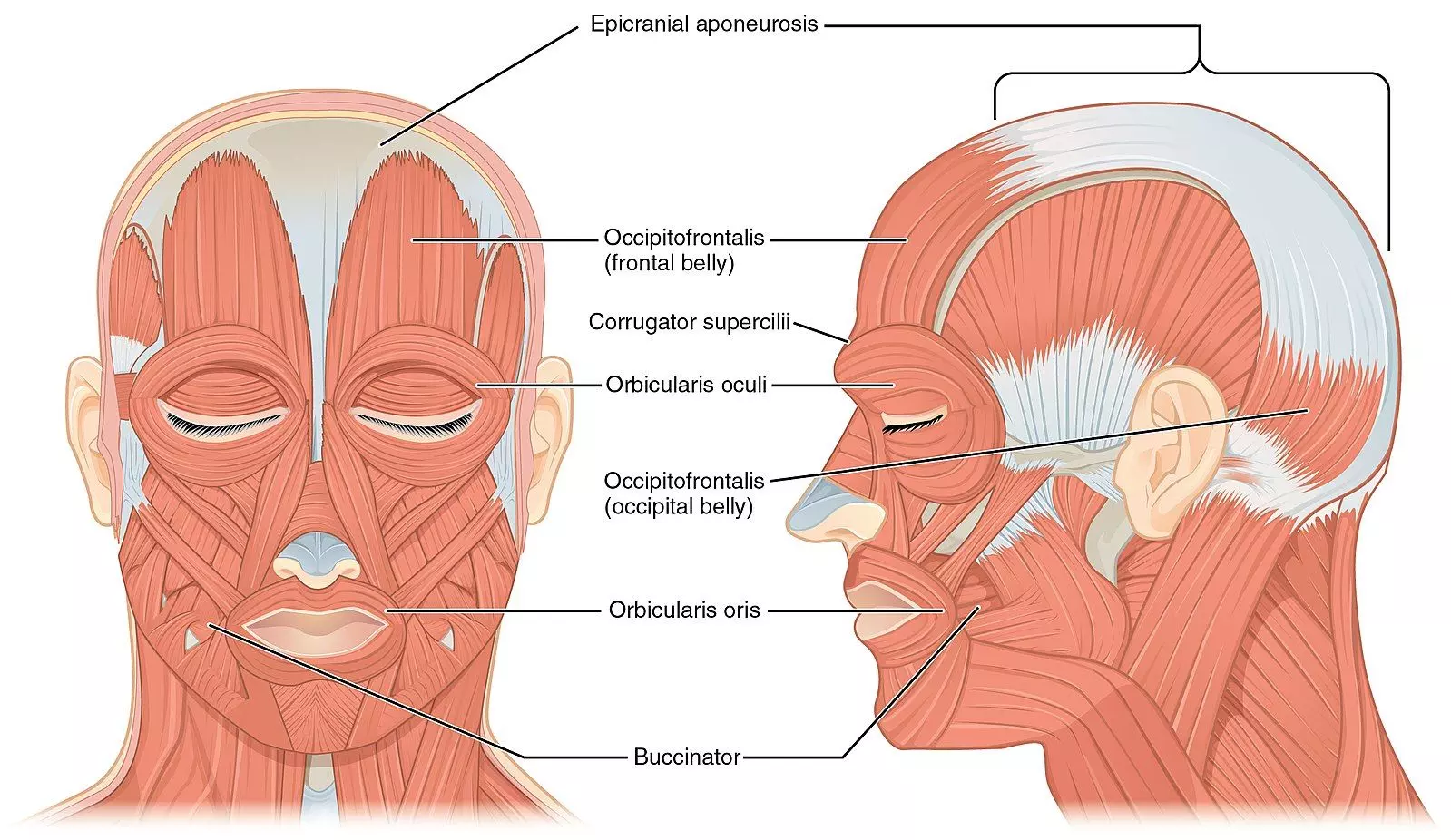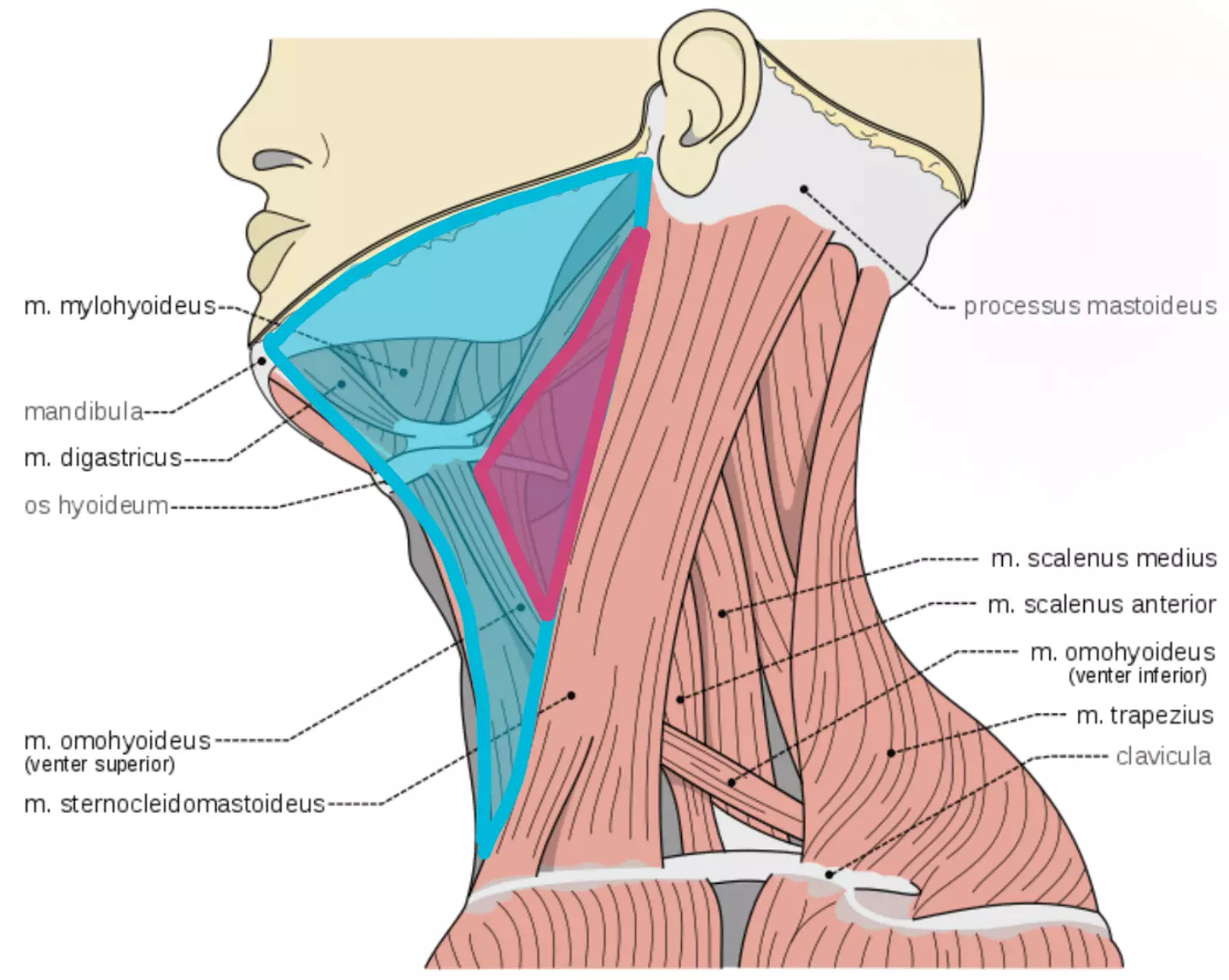Next Lesson - All done here! Check out our other subjects!
Abstract
- The neck is enclosed by one superficial and three deep layers of cervical fascia.
- The muscles in the head and neck are split into the muscles of mastication and muscles of facial expression, which are innervated by the trigeminal nerve and facial nerve respectively.
- There are a plethora of muscles responsible for facial expression, and four muscles responsible for mastication.
- The anatomical triangles (anterior, posterior, and carotid) are important areas of the neck, with specific communications within the body cavity or a target for surgery.
Core
The head and neck regions contain many very complicated structures. There are numerous vessels, nerves and muscles that are designed to facilitate the many functions of the head and neck.
The neck is the structure from the lower margin of the mandible to the upper border of the clavicle and is the pathway for structures to enter and leave the head.
Nature has compartmentalised structures using layers of cervical fascia, thin layers of connective tissue that form barriers between structures in the neck. There is one superficial fascia and three deep fascia.
There is a superficial fascial layer just below the skin, housing the jugular veins, superficial lymph nodes and the platysma muscle. On the image below, it is not labelled, but would run in the beige coloured soft tissue that surrounds the neck.
The investing layer of the deep cervical fascia is the most superficial of the three. It surrounds the neck like a collar and holds within it the sternocleidomastoid and trapezius muscles, and the submandibular and parotid salivary glands. On the image below, this layer is shown in orange.
The pretracheal layer of the deep cervical fascia is the next layer. It surrounds only the anterior and lateral parts of the neck. Its muscular component surrounds the infrahyoids, within its visceral component surrounding the thyroid gland, trachea and oesophagus. In the image below, the muscular component is shown in navy blue, and the visceral component is shown in lilac.
The prevertebral layer of the deep cervical fascia forms a sheath for the vertebral column and muscles associated with it. In the image below, it is shown in pink.
The buccopharyngeal fascia is a small portion of fascia that connects two parts of the pretracheal fascia to form a pocket containing the oesophagus and the trachea. It allows for the formation of the retropharyngeal space, a deep neck space that sits behind the buccopharyngeal fascia. Infections that develop in this space have the ability to extend into the thorax, potentially causing a life-threatening mediastinitis.

Diagram - A cross-section through the neck, showing the different fascia of the neck outlined in different colours
SimpleMed original by Maddie Swannack
The three key superficial muscles of the neck are the platysma, trapezius, and sternocleidomastoid muscles.

Table - Superficial muscles of the neck, their innervation and action
SimpleMed original by Ethan Kavanagh
The hyoid muscles are situated on the anterior neck and can be split into the suprahyoid and infrahyoid muscles, all of which attach to the hyoid bone in the neck. The four suprahyoid muscles are responsible for elevating the hyoid and depressing the mandible (opening the mouth). The infrahyoid muscles overlie the larynx and thyroid gland, acting to depress and stabilise the hyoid bone.
The scalene muscles are situated on the lateral side of the neck, and this group is made up of the anterior, middle and posterior scalene muscles. They contribute to the flexion of the neck and can be used as accessory muscles to aid in breathing.

Diagram - The muscles and the bones of the neck. The suprahyoid muscles are indicated by the green arrow head, the infrahyoid muscles are indicated by the blue arrow head, and the lateral muscles of the neck are indicated by the orange arrow head
Public Domain Source, edited by Maddie Swannack [Public domain]
These muscles can be classified based on their physical action – either they can constrict in a circular fashion or pull in a linear fashion.
The facial nerve supplies the muscles of facial expression.
It has five main extra-cranial (arising outside of the skull) branches, namely: temporal, zygomatic, buccal, mandibular and cervical (remembered by the mnemonic ‘to Zanzibar by motor car’).
It is important to remember that there are two facial nerves, left and right, which each supply respective halves of the face.
The platysma muscle is a very thin, sheet-like muscle that covers the anterior portion of the neck.
It depresses the lower jaw and tenses the skin of the neck.
It is supplied by the cervical branch of the facial nerve.
The orbicularis oculi muscle is the round muscle that surrounds the eye.
It is responsible for closing the eyelids.
It has two main divisions:
- The orbital portion is thicker, and its fibres form an uninterrupted ring around the eye. It is responsible for the forceful closure of the eye and is supplied by the temporal portion of the facial nerve.
- The palpebral portion is thinner and pale. It contains the preseptal and pretarsal muscles of the eyelid. This portion is responsible for the spontaneous blink and is supplied by the zygomatic portion of the facial nerve.
The occipitofrontalis is a muscle in the forehead responsible for raising the eyebrows.
It is supplied by the temporal portion of the facial nerve.
The orbicularis oris muscle encircles the lips.
It is responsible for closing the mouth and causing the lips to pucker, earning it the nickname ‘the kissing muscle’.
It is supplied by the buccal branch of the facial nerve.
The buccinator muscle sits between the mandible and the maxilla, forming the anterior portion of the cheek and the lateral portion of the oral cavity.
It is responsible for being able to pull back the corner of the mouth into a smile and flattens the cheek area to prevent food accumulation when chewing.
It is supplied by the buccal portion of the facial nerve.
The levator palpebrae superioris muscle is a muscle contained within the orbit that elevates the upper eyelid.
It is supplied by the oculomotor nerve.
If this muscle or the oculomotor nerve are not functioning correctly, the eyelid will droop, causing ptosis.
The epicranial aponeurosis is a dense layer of fibrous tissue that covers the top of the skull.
It has 5 layers, which spell out the acronym SCALP: Skin, Connective tissue, Aponeurosis of the Occipitofrontalis muscle, Loose connective tissue, and the Pericranium of the skull.

Diagram - The front and side views of the muscles of facial expression
Creative commons source by CNX Anatomy 2013 [CC BY-SA 4.0 (https://creativecommons.org/licenses/by-sa/4.0)]
Compared to the numerous muscles of facial expression, there are only four muscles responsible for mastication, the elevation and depression of the mandible to allow the chewing of food.
The trigeminal nerve supplies the muscles of mastication (the muscles responsible for chewing), as well as providing sensory innervation to the face through three branches, namely the ophthalmic, maxillary and mandibular branches. For more information on the trigeminal nerve, please see the article on the first six cranial nerves found here.
The four muscles of mastication are all innervated by a motor branch of the trigeminal nerve and they all act on the temporomandibular joint (TMJ). These muscles are:
- Temporalis
- Masseter
- Medial Pterygoid
- Lateral Pterygoid
The temporalis, masseter and medial pterygoids are all responsible for the elevation of the mandible, and together provide enough force to chew tough food.
The lateral pterygoid is the only muscle responsible for the depression of the mandible. It works in conjunction with gravity and the suprahyoid muscles to open the jaw.
The pterygoid muscles cannot be palpated. If an individual were to place their fingers over their temples (for temporalis) or over the corner of their jaw (for masseter) as they clench, they would feel the muscles contracting.
Structures that run between the head and the thorax are associated with the anterior triangle.
These structures include:
- Common carotid artery that bifurcates within the triangle into the internal and external carotid arteries.
- Internal jugular vein
- Cranial nerves – facial (VII), glossopharyngeal (IX), vagus (X) and hypoglossal (XII).
The borders of the anterior triangle are:
- Lateral – anterior border of the sternocleidomastoid muscle.
- Medial – imaginary sagittal line down the midline of the neck.
- Superior – lower border of the mandible.
The anterior triangle of the neck also contains the carotid triangle as a subclassification.
The carotid triangle is a region of the anterior triangle (mentioned above). It has the following boundaries:
- Superior – posterior belly of digastric muscle.
- Lateral – medial border of sternocleidomastoid muscle.
- Inferior – superior belly of omohyoid muscle.
The main contents of the carotid triangle are:
- Common carotid artery – which bifurcates within the triangle into the external and internal carotid arteries.
- Internal jugular vein
- Hypoglossal nerve
- Vagus nerve
Structures in the carotid triangle are quite superficial, making this triangle a frequent access point for surgical intervention.

Diagram - The anterior triangle in blue and the carotid triangle in pink. It shows the carotid triangle as a subdivision of the anterior triangle
Creative commons source by Olek Remesz, edited by Maddie Swannack [CC BY-SA 4.0 (https://creativecommons.org/licenses/by-sa/4.0)]
Posterior Triangle of the Neck
Structures that run between the thorax/neck and upper limb are associated with the posterior triangles.
These structures are:
- External jugular vein
- Subclavian vein and subclavian artery
- The accessory nerve (cranial nerve XI)
- Cervical plexus, including the phrenic nerve
- Trunks of the brachial plexus
The borders of the posterior triangle are:
- Anterior – posterior border of sternocleidomastoid muscle
- Posterior – anterior border of trapezius muscle
- Inferior – middle 1/3rd of the clavicle
Structures of the posterior triangle are important surgically:
- The subclavian vein can be used as a point of access to the venous system via a central catheter.
- The cervical plexus can be blocked using local anaesthetics.

Diagram - The posterior triangle of the neck in green
Creative commons source by Olek Remesz, edited by Maddie Swannack [CC BY-SA 4.0 (https://creativecommons.org/licenses/by-sa/4.0)]
Edited by: Dr. Maddie Swannack
Reviewed by: Dr. Thomas Burnell
- 11080

